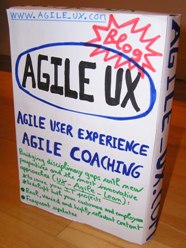Posted by jc-Qualitystreet on 2011/03/04
Activity #1 of the Agile UX practitioner…
The Agile UX practitioner helps to define the product Vision…
Agile or not, the Vision is crucial
At an organization level, the vision helps to appreciate and believe in the company. On a daily basis, and from a team and employee point of view, it’s a good way to create meaning in work.
One product, One Vision…
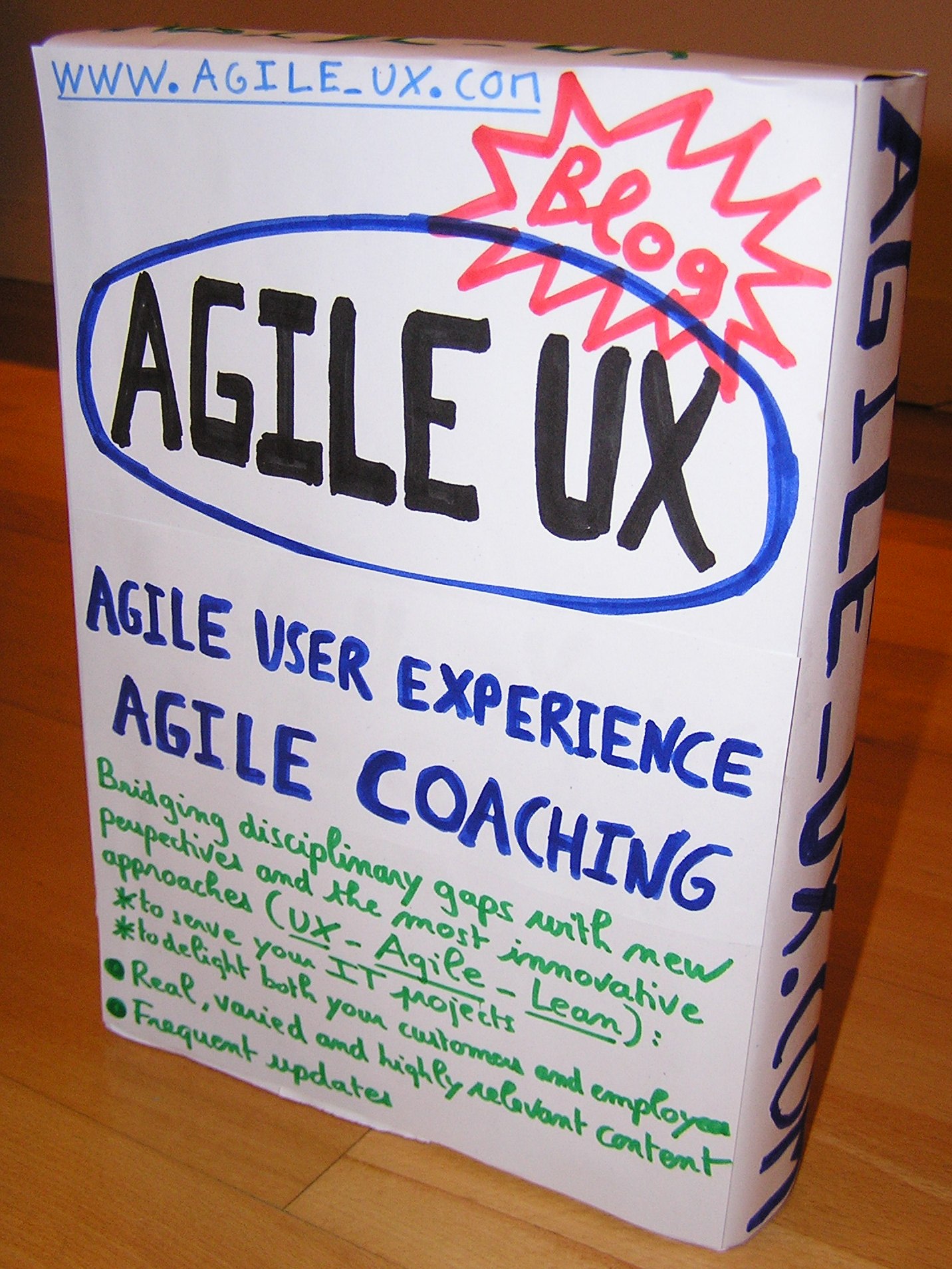
Any product...
At any product is necessarily associated with a Vision, setting the course, giving meaning and describing what is envisioned for the product in the short, medium or long term. The product Vision and the Personas form the foundations of the entire user experience of the product (Strategy element).Vision is also the highest level of agile planning (Daily-> Sprint -> Release -> Roadmap -> Vision)
« Fits in a shirt pocket, syncs seamlessly With PC, fast and easy to use, No more than $ 299 « …
like the vision of Hawkins for the Palm Pilot, the product vision is often short, goals driven and related to a problem.
But to be meaningful, effective and to federate individuals around it, the product vision must be shared with the team. In Scrum, that is the job of the Product Owner, and that should be completed before the team starts working its first sprint.
Building and sharing the product vision is a huge challenge for the Product Owner. And the Agile UX practitioner has an important role to play (as a workshop facilitator or input provider based on user research) to help him in such difficult task. Again, collaboration is the key and the most effective techniques to define and share the vision are collaborative. Here is a focus on the main activities and facilitation techniques I use during the Vision workshops with my clients.
PRODUCT VISION BOX (my favorite)
From Highsmith (2004). The « Product Vision Box » is a very appropriate technique when starting a project to create the vision and share it with the team responsible to design the product (and why not, those in charge of the sale).
One product = One Vision = One Product Vision Box
The all team creates a visual, concrete image of the software, product or service which it is supposed to develop. They build together their own product vision BOX. So, the final result is always a single box, although in the context of the workshop, several intermediate boxes can be created by sub-groups.
This final box is built collectively in the consensus and collaboration. It represents the shared vision, and includes the following elements:
- Front: Name – Picture or drawing (if possible) – Slogan – 3 / 4 Bullets arguments for Sale
- Back: A more detailed view with more functionality, the pre-requisites …
The workshop has a playful side. It promotes discussions, collaboration and requires participants to go straight to the point and set priorities.
FRONT

Front: Product Vision Box of this blog!
BACK
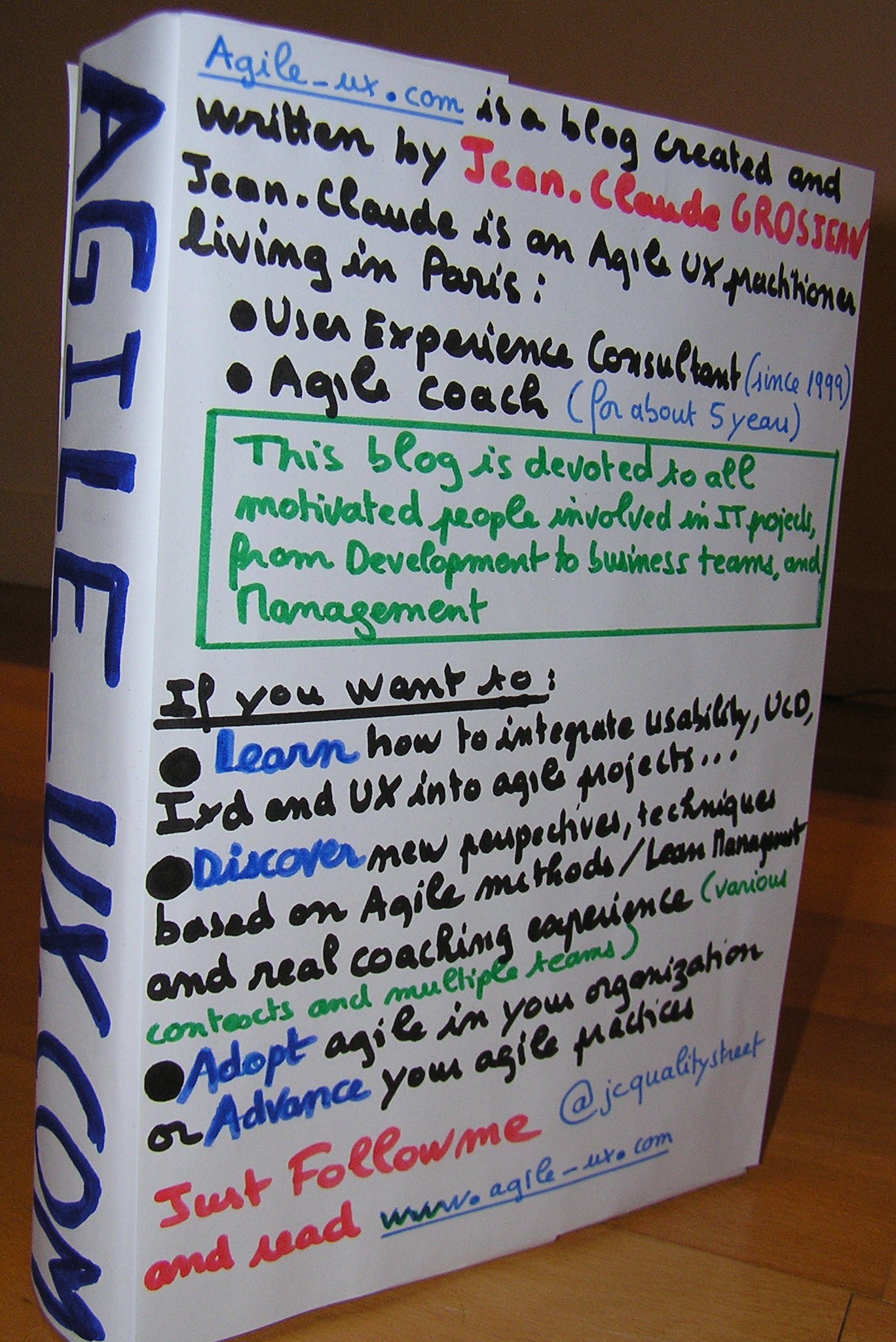
Back: Product Vision Box of this blog!
PRODUCT BOX (the most UX)
From Hohmann (2006). The Product box is one of the most useful and popular « innovation games ». The technique is both very close to the previous format and different (due to its strong « UX » connotation »). With the product box we really have the VOICE of THE CUSTOMER.
One Product = n Visions = n Boxes
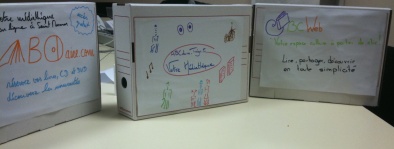
Product Boxes...
The « Product Box » workshop is above all customer-oriented. Its purpose is to collect the maximum users’ feedbacks about an existing product. So users are invited to participate to the « game »: designing the box that they would buy, and then to imagining that they’re selling the product at a trade show or at the supermarket (represented by the facilitator and the other customers).
The cereal box is a good example to introduce the game to the participants.

Example of a cereal box
Customers can work individually or form sub-groups (3 persons). The box (the customer vision) includes the same elements as above (and more …)
- Front: Name – Picture or drawing (if possible) – Slogan – 3 / 4 Bullets arguments for Sale
- Back: View more detailed with more functionality, the pre-requisites…
The « Product box » technique is highly relevant to innovation. It is very useful in view of improving the product, or to explore and collect users’ needs. My objective as a facilitator is to get the maximum of boxes, even if at the end of the workshops, an important work of analysis has to be planned.
How does it work?
- 40 minutes to design the box (individually or in groups of 3 persons)
- And 5 minutes by box to sell it to other groups or individuals.
The Product box can guide a final vision by drawing what customers want, how they envision the product, what they expect, what they find most interesting, what they focus on, and also what arguments they use to sell it. If I took the example of my blog , I would invite 16 passionate readers of agile-ux a Saturday afternoon, to create several AgileUX Vision boxes and sell it to the others… 🙂
Vision Statement (a must!)
From Moore (1991). It is also called « the statement of position » or « Elevator Pitch ». Actually it’s a formula to pass the famous elevator test (explain your product in the time it takes to ride up in an elevator).
The model is really efficient: I use it consistently with my clients. It is a precious facilitation tool useful to explore, create and share a product vision.

The Vision formula applied... On the wall, with the team, from the beginning to the end of the project
The vision statement is structured into 6 sections that summarize in less than two minutes (elevator pitch) the vision of the product.
FOR (target for the product)
WHO (users’ needs)
OUR PRODUCT IS (the product category)
THAT (major benefit, key functionalities)
UNLIKE (current practice, competition)
OUR PRODUCT (major differentiator)
A two-column presentation is a good practice but a linear version (elevator pitch format) works well too…
Posted by jc-Qualitystreet on 2010/12/23
Agile marketing is a new mindset for marketers who adopt agile principles and practices in their daily activities (agile Marketing taskboard: why marketers love it?)
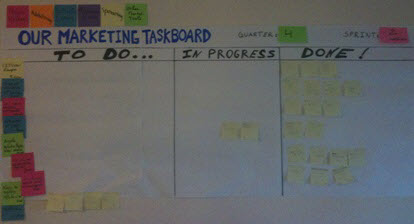
Agile Marketing Taskboard for Marketers
But Agile marketing is first the realization of IT projects for marketing using agile development This kind of project can only succeed and flourish in short cycles, with frequent deliveries, lead by FEEDBACK and open to change.
As pointed out recently Lubomira Rochet (Valtech), proposing the right product to the right person in the right context at the right time is key for digital marketing and to secure competitive advantage in a world where everything is accelerating.
To achieve it, the future of marketing will be primarily to deliver early, to test, test again and again, measuring and continuously adapt. A set of activities very closed to the Kaizen principle (continuous improvements), pillar of Lean thinking, and finally the real challenges which only an agile and lean approach can face with effectiveness and efficiency.
Good… but the agile marketing dynamics doesn’t come without impact and requires reflection.
Impact of Agile marketing 1… Undeniable benefits for Marketing and Business in general…
- Align IT and Business to the same Vision and objectives
- Deliver early and often to get the maximum of value and feedback
- Improve team morale, motivate and engage people
These are the major advantages of agile marketing but not only…
- enhancing the ability to influence the progress of the project, including changing priorities, better managing emerging needs and adapting to an environment of change (via an emergent product backlog);
- improving project visibility through visual management and extensive information radiators
- accelerating time to market through a single objective: getting the most valuable elements as soon as possible;
- getting a better adaptation to user needs through numerous opportunities for feedback, earlier and more frequent interactions, demonstrations and regular deliveries to meet new requirements (Test – Measure – Adaptation)…
are other benefits of agile marketing.
Impact of Agile marketing 2… Duties and the necessity to collaborate…
- Bring EVERYBODY TOGETHER, IT and Marketing, and establish an environment of trust
- Facilitate COOPERATION and foster effective COLLABORATION throughout the project (from the beginning to the end)
- Bring out a new role: the Product Owner with a set of responsibilities
- Empower teams
- Cut projects in short sprints (with a duration of 1 week, 2 or 3 weeks …)
- Establish a delivery cadence
- Test, Test, Test… Inspect and Adapt!
- Do just enough formalism, procedures and seek to eliminate wastes at all levels
Impact of Agile marketing 3… continuous reflection on a delivery cadence
On one hand, delivering earlier and more frequently can generate more revenue (new billing conditions, customer retention or acquisition …).
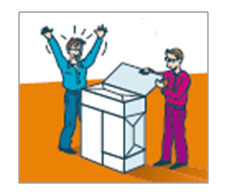
A successful Delivery !
It is also quite suitable for digital marketers that need to test again and again various options and multiple configurations to optimize their conversion rates, to meet user needs, or simply create effective « landing pages ».
On the other hand (and other contexts), switching from one to several releases a year entails additional work. It has a cost and must be prepared. Moving from 1 to 4 releases a year like SalesForce or going to 45 releases like PatientKepper is not easy task. Cost and technical considerations are crucial but other factors should be taken into account:
- The involvement and availability of teams (development, business, support, sales, operations)
- The synchronization effort required
- The capacity to work frequently on the required deployment artifacts
- The willingness of the users to change their habits, to learn new functions, to reinstall applications, to acquire new licensees
- The balance between the desire to initiate a continuous conversation with its users by offering them as regularly as possible new features and the risk of losing these innovations in the mass of multiple announcements about the Product .
- The natural rhythm of the market
So, agile marketing is challenging and involves coordination of many people. Great benefits can be expected but impacts inside or outside the organization don’t have to be underestimated.
Posted by jc-Qualitystreet on
… Because their goal is to create the maximum value for the customer or prospect, as quickly and efficiently as possible;
… Because the Agile and Lean approach is the best way to deliver the right message at the right time to the right person.
Agile marketing is first the realization of IT projects for marketing using agile development… BUT it is also, from another perspective, the adoption of agile values, principles and practices beyond software in Marketing. And that is NEW!

The agile marketing taskboard
After IT teams, this is now the marketing teams who want to become Agile. And some companies have even already taken the opportunity to adopt agility in their own business …
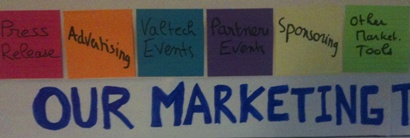
Agile Marketing Themes
The number of examples showing companies applying Agile & Lean practices beyond IT, such as in Communication, Training, Sales, or Marketing increases …
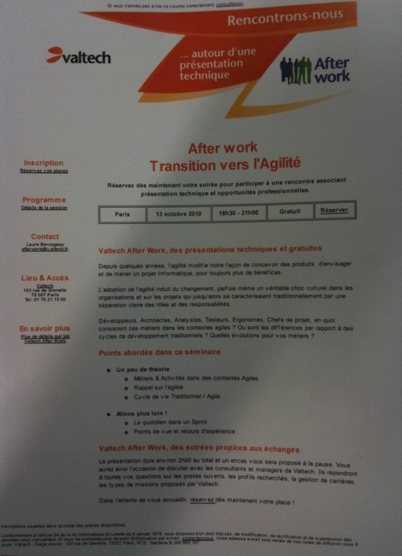
AfterworkAgile: An Agile marketing USER STORY
Via my French blog, I’ve heard about interesting projects outside the context of software development. In addition, my coaching activities enable me to work with Business people (often assigned to the role of Product Owner). Often, these inspiring and smart people quickly detect the potential benefits of Scrum or Kanban, in their daily activities.
See, adopt, adapt and replicate what really works!
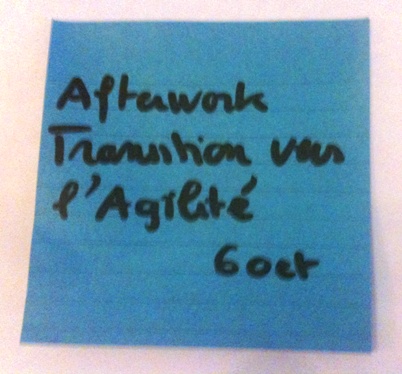
The same user story as a post-it placed in taskboard
The keys of Agile Marketing for marketing teams
- Adopt Agile planning with different levels of details and commitments:
- The Roadmap level (annual)
- The release Level (quarter)
- The Sprint level (with a duration of 3 weeks for Marketing Teams)
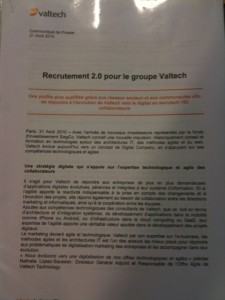
A Press Release User story (item of the sprint)
- Create a Taskboard to visualize and monitor the flow of activity (tasks) during the current Sprint

Taskboard - Quarter - Sprint
- Use visual Management (displaying the taskboard and important marketing tools for a better description, elicitation and understanding)
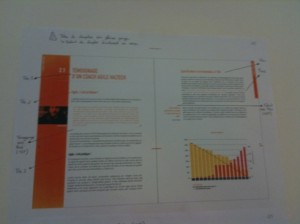
Visual management for marketing actions
- Use short cycles, called sprints. These short period of time (2 or 3 weeks) will also include Scrum ceremonials:
- Planning meeting: 1st day of the Sprint plan for all marketing activities for the next three weeks and the tasks to achieve it
- DailyScrum: Every day in the morning, no more than 10 minutes to synchronize, measure progress and identify impediments
- Sprint Review & Retrospective: Last day of Sprint, to inspect and adapt…
- Focus on Agile values (Courage, Communication, Feedback, Simplicity, Respect) for the team in its way of working together but also in its relations with internal and external partners….
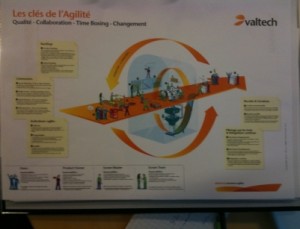
Keys to Agility... not only a User Story 🙂
- Use the user stories (categorized into themes and decomposed tasks that will be moved on the taskboard) for your marketing actions
- Gradually, calibrate your sprints by estimating your user stories, and at the end of each sprint, take the time for continuous reflection and improvement.
Posted by jc-Qualitystreet on 2010/12/10
First article dedicated to the responsibilities of the Agile manager, who has a major role to play in the agile adoption. At a time when the era of management 3.0 (a lean and agile management) is announced, the role manager is evolving, between opportunity and necessity
#1 Initiate and support communities of practice… which means
- Give time and resources to agile communities, ScrumMaster, Agile coaches, Product Owner, Agile Testers, Architects, UX Groups …,
- Give feedback on what is done by the communities of practice
- Promote agile communities of practice in the organization
- And why not participate and animate some communities (in a role of coordinator)
Communities of practice are an essential feature of the agile transformation programs we undertake. They are the perfect illustration of the « Yokoten » technique (the horizontal transfer of information and knowledge across the enterprise) used by Lean practionners.
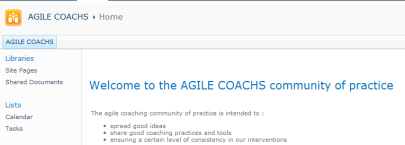
Agile coaching Community of Practice
What is a community of practice?
« Communities of practice are groups of people who share a concern or a passion for something they do and learn how to do it better as they interact regularly. » Etienne Wenger
The idea is not new, but makes sense now, at a time when companies are reconfiguring to become agile, and seek to increase the number of their dedicated, CROSS FUNCTIONAL and self-organized teams. Communities of practice are aligned to this purpose and enable to:
- Exchange on current practices
- Deepen knowledge and expertise
- Spread good ideas, practices and tools in the organization
- Bring together people across teams or product lines
- Coordinate and ensure the necessary consistency between the teams
Our community of practice is not a facebook like!
Its identity is built around the common interest for a specific DOMAIN and the willingness to learn. Passion, learning and commitment are the foundations of the community of practice. For example, I voluntarily belong to the « Agile Coaching » community of practice… because I am an agile coach, highly interested in the topic. But also because I want to contribute, share and discuss with other coaches (experienced or not). And, of course because I want to improve my own PRACTICES.
The same for the ScrumMaster… sometimes feeling alone, isolated within the team, he often needs to challenge himself and wants to discuss and share with the other ScrumMasters of the organization… The community of practice is primarily PRACTICES-ORIENTED, and focus on lessons learned, problems, solutions and vision. The community of practice is collective, dynamic, and collaborative. Members help each other and share information with a COMMUNITY mindset.
And the agile manager?
Communities of practice are not intended to appear in organizations chart. But even if they remain informal, they have a strong need for recognition and support.
Thus the role of the manager is crucial to face the five main challenges (organizational, managerial, community, personal and technical) related to the establishment of such communities in the company. Setting up new rules in the organization to facilitate the communities is often needed. The agile manager will also have to encourage and motivate people to participate, give feedback and handle the technical and logistics aspects to enable communities to express themselves online… and face to face. Because building a community of practice also requires solid relationships between the members, meeting physically and regularly is necessary. It has a cost and must be prepared. The openness of the community towards the outside of the company is also an important point of discussion with management.
At last, enabling the communities of practice to succeed and to flourish in the organization requires the recognition from HR and management of new collaborative skills among communities’ members. A community of practice is collective game.
For both the organization and the individual, the community of practice is the opportunity for knowledge capitalization and improvement. The communities of practice are highly valuable … and this is the responsibility of the agile management to support and develop them!
Posted by jc-Qualitystreet on 2010/12/05
But also a necessity!
The era of agile and lean management (see Management 3.0: Being an Agile Manager) is announced, and many factors contribute to the awareness and the birth of a sense of urgency that can serve as a starting point of willingness to change to lead middle managers to become agile managers.

The Agile Manager: Leadeship & Facilitation
The Enterprise environment
Fast, complex, competitive, changing, the external environment impacts the company itself. Pushed to review its governance, processes and valuable assets, the organization must also differentiate itself from its competitors in terms of knowledge, information sharing, skills and career management. The agile and lean enterprise is an obvious answer to these challenges, and middle managers, first line for these activities, have a major role to play. Whether supporting or opposing, they will be highly impacted by the fundamental changes introduced by an agile and lean approach.
The Rise of agility
Agile methods have spread into projects and in the everyday business life of people. Very popular in IT projects, agility is now everywhere and difficult to avoid. Managers can’t ignore it anymore. Moreover to understand what people actually do and how IT teams work, middle management will require the appropriate level of agile information and training… first steps toward change?
Concrete and visible results
It’s also difficult for middle management to ignore the benefits provided by Agile methods. Agility enables organization to reduce time to market, to improve product quality, to increase project visibility and productivity. Better team satisfaction and better end-user satisfaction are also observed. Agile methods have shown their efficiency and proved that it worked. Ten years after the Agile Manifesto, birth of Agility, agile and Lean practices continue to spread at a « unsustainable » pace 🙂 With the appropriate level efforts, an agile and lean approach gives fantastic results. So, why not applying some of these good practices and using them as a source of inspiration for management activities?
People expectations
Of course some needs and expectations of working people (achievement, recognition, empowerment…) are not new but the agile mindset is! An agile mindset grows within team members working with agile methods, and changes their relationship with others, with work and with their company. Collaboration, courage, feedback, simplicity and respect, the fundamental agile values are now also expected outside of the agile team, and primarly with middle management and hierarchy. Trust and feedback will be the keys.
From a generational point of view, the rapid growing of digital natives (people born after 1978) inside companies also changes the face of the enterprise and how the businesses operate. Digital natives need real time interactions & collaboration, networks, communities and a new management style. Once again, I have the feeling that agile management is a very good option to address the needs of this specific population.
HUMANITY, FACILITATION, COLLABORATION and LEADERSHIP seem to be the key characteristics of the AGILE MANAGER. And inspiration can be easily found in these few principles of lean management:
- Base your management decisions on a long term philosophy… even at the expense of short-term financial goals
- Grow leaders… who thoroughly understand the work, live the philosophy, and teach It to others)
- Develop exceptional people and teams… who follow your company’s philosophy
- Respect your partners and suppliers... by challenging them and helping them improve
- Go and see for yourself… to thoroughly understand the situation
- Make decisions slowly by consensus… thoroughly considering all options implement rapidly
- Become a learning organization... through relentless reflection (Hansei) and continuous improvement (Kaizen)

















